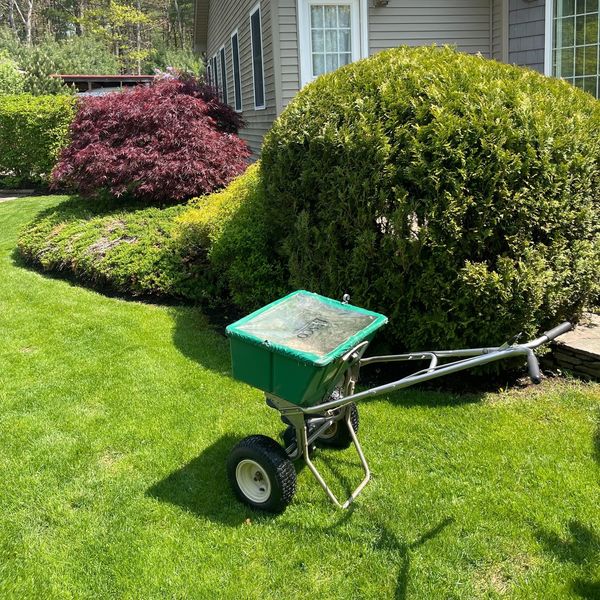Spring’s here, and your lawn is waking up from its winter slumber. You’re probably seeing patchy grass, unwanted weeds, and the daunting task of getting it all back to normal.
But don’t worry, we’ve got you covered. Switching to these lawn care practices not only solves these problems head-on but also nurtures your lawn in a more sustainable way.
In this blog, we’ll share the top 7 spring lawn care tips to help you keep your lawn healthy this spring.
Understanding Your Lawn’s Spring Needs
Spring breathes new life into your garden, but it also brings the challenge of understanding what your lawn truly needs after the cold months. Here’s how to kick things off:
- Assessing Lawn Health Post-Winter: Take a walk around your yard. Look for areas that seem a bit damaged. It’s the first step to figuring out your action plan.
- The Benefits of Early Spring Lawn Evaluation: Spotting trouble early means you can fix it before it gets out of hand. It’s about giving your lawn what it needs, right when it needs it.

Starting with Soil Improvement
Healthy lawns start with healthy soil. It’s not just about what’s on the surface. Here’s how to ensure your soil is ready to support a lush lawn:
- Testing Soil pH and Nutrients: A simple test can tell you a lot about your soil’s health. Is it too acidic or alkaline? Does it have the nutrients your lawn craves?
- Soil Amendments for a Healthy Lawn: Whether it’s adding compost, manure, or fertilizers, enriching your soil organically can make a huge difference. It’s like a health boost for your lawn
Weed and Crabgrass Prevention
Weeds and crabgrass are like uninvited guests at your lawn party. Here’s how to keep them off your guest list:
- Identifying Common Spring Weeds: Know your enemy, right? Learn to spot the usual suspects early—dandelions, crabgrass, and clover—so you can target them effectively.
- Natural Weed Preventatives and Controls: Mulching, boiling water, and vinegar are your lawn care weapons. They’re simple, effective, and you probably already have them in your home.
The Right Way to Water Your Lawn
Water is life, especially for your lawn in spring. But there’s an art to watering the right way:
- Efficient Watering Practices for Spring: Early morning is the best time to water your lawn. It minimizes evaporation and ensures the water goes deep into the roots where it’s needed most. For small lawns, using a handheld sprinkler or watering can allow for precise watering and avoid water wastage. For medium-sized lawns, a pulsating sprinkler or a sprinkler system with adjustable spray patterns can provide even coverage. Large lawns may benefit from a sprinkler system with zone controls, allowing for targeted watering in specific areas.
- Avoiding Common Watering Mistakes: Overwatering is just as bad as underwatering. Stick to the rule of an inch of water per week (including rainfall), and your lawn will thank you. To measure an inch of water per week, you can place an empty tuna can or any other shallow container in your yard while you water. When the water in the can reaches a depth of one inch, you’ll know you’ve watered enough. Keep in mind that this measurement includes rainfall, so adjust your watering accordingly.
Fertilization Techniques
Feeding your lawn the right stuff doesn’t mean chemical solutions. Here’s how to nourish your lawn:
- Choosing the Right Fertilizer: Not all fertilizers are created equal. Look for options that release nutrients slowly, feeding your lawn steadily and healthily. Some popular types of organic fertilizers include compost, which is made from decomposed matter, such as food scraps and yard waste; bone meal, which is high in phosphorus and is derived from animal bones; and seaweed or kelp meal, which is rich in trace minerals and can improve soil structure. Other options include fish emulsion, which is made from fermented fish, and chicken manure, which is high in nitrogen.
- Timing and Application Tips for Best Results: Timing is everything. Apply fertilizer in early spring to kickstart growth and follow up as needed without going overboard.
The Importance of Dethatching
Thatch might sound like a cozy blanket for your lawn, but too much can suffocate it. Let’s clear the air:
- What is Dethatching, and Why Does It Matter? Thatch is a layer of dead grass and roots at the soil’s surface. Removing it helps water, nutrients, and air reach the soil more effectively.
- DIY Dethatching Tips: With a thatching rake or a dethatcher, you can do this yourself. It’s a workout, but your lawn will breathe easier and thank you for lush, green grass.

Aeration for a Healthy Lawn
Think of aeration as your lawn taking a big, deep breath. It’s all about letting those roots breathe and grow:
- The Benefits of Lawn Aeration: Aeration punches small holes in your lawn, allowing water, nutrients, and oxygen to penetrate the soil. This can lead to a more robust, resilient lawn.
- How and When to Aerate Your Lawn: The best time to aerate your lawn is during its peak growing period, which for most grass types means early spring or fall. To make the job easier, use a hand aerator, rent a machine, or use professional lawn care services.
Overseeding: Spring vs. Fall
Bare spots or thinning grass? Overseeding might be your answer. Here’s how to fill in the gaps for a lush lawn:
- The Advantages of Spring Overseeding: Spring brings warm soil and plenty of moisture, creating ideal conditions for seed germination. It’s a great time to introduce new, hardy grass varieties.
- How to Properly Overseed Your Lawn: Start with a clean slate by mowing your lawn short and removing any debris. Choose a high-quality seed that matches your existing lawn, and don’t forget to keep the new seeds moist until they’re well established.
Maintaining Your Lawn Through Spring
Maintaining your lawn requires consistent and mindful attention. Let’s see how to keep your lawn looking great without spending a lot of time and effort on it.
- Regular Maintenance Tips for Spring Lawn Care: Mow at the right height, leaving the grass a bit longer to promote root growth and shade out weeds. Also, embrace leaves as natural mulch or compost them for added nutrition.
- Monitoring Lawn Health and Adjusting Care: Stay observant. If you notice signs of stress or pests, address them with best lawn solutions. It’s about being proactive, not reactive, when it comes to lawn care.
When to Consider Professional Lawn Care Services
An expert eye can spot issues you might have missed and recommend the best lawn treatments. So, consider hiring a professional lawn care company that provides best lawn care services.

Ready for a Lush, Green Lawn This Spring? Discover Our Services!
Spring is the season of lawn renovation, the perfect time to bring your lawn back to its vibrant, healthy self. At 855RILAWNS, we’re here to ensure that rejuvenation is not only thorough but also sustainable.
Our specialized spring lawn care services are designed to tackle everything winter left behind, from leaves and branches to debris scattered across your landscape.
But we don’t stop at cleanup; our comprehensive approach, which sets us apart, includes cutting back non-woody perennials and complimentary lawn mowing.
What makes our services unique?
- Detailed Cleanup: Beyond just removing leaves and sticks, we ensure your entire property is pristine and ready for new growth.
- Organic Lawn Care: Our focus is on sustainable practices, from soil amendments to eco-friendly weed management.
- Custom Scheduling: Opt for an early spring cleanup or a later service to fit your life.
- Beyond Basics: With ‘You Rake ‘em, We Take ‘em,’ we even handle leaf removal hassle-free.
Serving all of Rhode Island, our team is dedicated to enhancing your outdoor space with expert, insured, and satisfaction-guaranteed services.
Ready for a healthier, greener lawn without the hassle?
Contact us today for your fast, free quote, and let us do the heavy lifting this spring!


